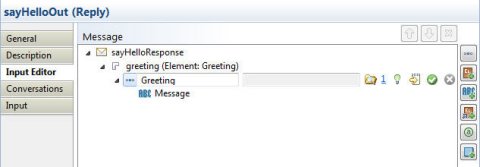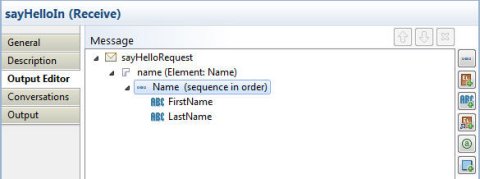Input and Output
The Input tab is used to enter the data for an activity and the Output tab displays the output schema of an activity.
Configuring the Input Tab
The Input tab is available in the Properties view and is used to enter data for an activity. Input data for an activity can be any of the following:
- Constant/Literal specified using numbers or strings enclosed in quotes.
- Regular Expression specified using an existing schema item or by keying in a constant expression in the field.
- Mapping the output from previous activities to the current activity's input. Using the mapper, you can choose functions or constants from the Functions and Constants tabs with the mapped data.

To create a mapping:
Right-Click Menu
When you select an element in the Activity Input schema and right-click, a popup menu appears. The Surround With menu item contains several sub-items that are useful shortcuts for creating XSLT statements.
| Option | Description |
|---|---|
|
Surround with Choose |
Choose statements enable you to conditionally specify the mapping based on an expression. Choose statements consist of a When clause to specify the condition you want to test, the mapping you want to perform if the condition is true, and an Otherwise clause to contain a mapping to perform if no conditions evaluate to true. An example of using a Choose statement is when more than one fault message is handled by the same Catch Fault task. |
| Surround with If |
If statements enable you to specify a condition, and if the condition is met, then the specified mapping is output. When you choose this option, an If statement appears before the selected element, and you must place an XPath expression in the If statement that evaluates to a boolean. If the expression evaluates to true, the specified mapping is performed. If the expression evaluates to false, the mapping is not performed and no value is set for the item. Do not place an If statement around schema data components that are marked as required. |
| Surround with For-Each |
For Each statements enable you to execute one or more statements once for each data element in a list. When you choose this option, a For Each statement appears before the selected data component, and you must place an XPath expression in the For Each statement that evaluates to a list of zero or more items. This is useful when you want to manipulate sequences or repeating elements. |
| Surround with For-Each-Group | A shortcut for moving the current element into a For-Each-Group statement and adding a Group-By grouping statement. The
current-group() is not provided on the source side. When you create for-each binding under a for-each-group, it adds current-group() by default. The Grouping statement creates the list grouped by the desired element, and the
current-group() function allows you to access the items in the requests repeating element that correspond to the group that is currently being processed. |
Configuring the Input Editor Tab
Using the Input Editor tab you can configure the input data for an activity.

Instead of specifying a constant or an expression for the schema item, you can first configure the sequence in which this message appears by setting up the element it is contained in.
You can define the sequence of an element using the icons on the right:
 Add Complex Anonymous Type: Adds an element sequence that is defined by the following:
Add Complex Anonymous Type: Adds an element sequence that is defined by the following:

- Schema type definition or creating a new type definition.
- Number of Minimum Occurs (default is 1).
- Number of Maximum Occurs (1 or unbounded).
- Number of references to this resource (generated, in this case it is 0).
- Initiate Rename Schema Element: rename the schema element by entering the New Name and choosing the option whether to update the references to this element.
- The remaining icons are Go To
 , Accept Changes
, Accept Changes
 , and Delete
, and Delete
 , which invoke the general editing tools.
, which invoke the general editing tools.
 Add Complex Element: This option adds a complex element that you can further define by the following:
Add Complex Element: This option adds a complex element that you can further define by the following:

- The schema type definition or a new type definition (default is
anyType) - Number of Minimum Occurs (default is 1).
- Number of Maximum Occurs (1 or unbounded).
- Number of references to this resource (generated, in this case it is 0).
- Initiate Rename Schema Element: rename the schema element by entering the New Name and choosing the option whether to update the references to this element.
- The remaining icons are Go To
 , Accept Changes
, Accept Changes
 , and Delete
, and Delete
 , which invoke the general editing tools.
, which invoke the general editing tools.
- The schema type definition or a new type definition (default is
 Add Primitive Element: This option adds a primitive element that you can further define by the following:
Add Primitive Element: This option adds a primitive element that you can further define by the following:

- Choosing by the Primitive Types: String, Integer, Decimal, Boolean, Date&Time, Binary, URI or Any.
- Choosing by the Primitive Sub Types: String, Normalized String, Token, Language, Name. NC-Name, Q-Name, Name Token, Name Tokens, ID, ID ref, ID refs, Entity, and Entities.
- Number of Minimum Occurs (default is 1).
- Number of Maximum Occurs (1 or unbounded).
- Number of references to this resource (generated, in this case it is 0).
- Initiate Rename Schema Element: rename the schema element by entering the New Name and choosing the option whether to update the references to this element.
- The remaining icons are
Go To
 ,
Accept Changes
,
Accept Changes  , and
Delete
, and
Delete  , which invoke the general editing tools.
, which invoke the general editing tools.
 Add Reference Element: This option adds a reference element that you can further define by the following:
Add Reference Element: This option adds a reference element that you can further define by the following:

- The schema type definition or a new type definition.
- Specifying the Minimum Occurs number (default is 0).
- Selecting from the drop-down list the Maximum Occurs number (1 or unbounded.)
- The remaining icons are
Go To
 ,
Accept Changes
,
Accept Changes  , and
Delete
, and
Delete  , which invoke the general editing tools.
, which invoke the general editing tools.
 Add Attribute: This option adds an attribute that you can further define by the following:
Add Attribute: This option adds an attribute that you can further define by the following:

- Choosing by the Primitive Types: String, Integer, Decimal, Boolean, Date&Time, Binary, URI or Any.
- Choosing by the Primitive Sub Types: String, Normalized String, Token, Language, Name. NC-Name, Q-Name, Name Token, Name Tokens, ID, ID ref, ID refs, Entity, and Entities.
- Use Optional/Required (default is Optional).
- The remaining icons are
Go To
 ,
Accept Changes
,
Accept Changes  , and
Delete
, and
Delete  , which invoke the general editing tools.
, which invoke the general editing tools.
 Add Any Element: This option adds an element that you can further define by the following:
Add Any Element: This option adds an element that you can further define by the following:

- Wildcard Namespace (a space-delimited list of the namespaces can be entered).
- Entering the Minimum Occurs number (default is 0).
- Selecting from the drop-down list the Maximum Occurs number (1 or unbounded.)
- The remaining icons are
Go To
 ,
Accept Changes
,
Accept Changes  , and
Delete
, and
Delete  , which invoke the general editing tools.
, which invoke the general editing tools.
Viewing the Output Tab
The Output tab is available in the Properties view and is used to display the activity output schema. The output of an activity is displayed for informational purposes only and cannot be modified or altered.
The output tab displays the activity output schema. This name appears in subsequent activities input tabs. The activity output data is displayed for informational purposes only and cannot be modified or altered.

Configuring the Output Editor Tab
Input Editor allows a GUI based approach in configuring the output data.

Using the icons on the right, additionally define the
Name in
element. The icons have same meaning as when used for the Input Editor.